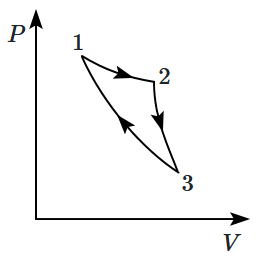In a Carnot cycle, order of process is:
1. isothermal expansion, adiabatic expansion, isothermal compression and adiabatic compression.
2. isothermal compression, isothermal expansion, adiabatic compression, and adiabatic expansion.
3. adiabatic expansion, isothermal compression , isothermal expansion, and adiabatic compression.
4. none of the above.
Consider a cycle followed by an engine, \(1~\text{to}~2\) is isothermal, \(2~\text{to}~3\) is adiabatic, \(3~\text{to}~1\) is adiabatic. Such a process does not exist because:

| 1. | heat is completely converted to mechanical energy in such a process |
| 2. | mechanical energy is completely converted to heat in this process, which is not possible. |
| 3. | curves representing two adiabatic processes don't intersect. |
| 4. | curves representing an adiabatic process and an iso-thermal process don't intersect. |
By opening the door of a refrigerator inside a closed room:
1. you can cool the room to a certain degree.
2. you can cool it to the temperature inside the refrigerator.
3. you ultimately warm the room slightly.
4. you can neither cool nor warm the room.
An ideal gas undergoes four different processes from the same initial state (figure). Four processes are adiabatic, isothermal, isobaric and isochoric. Out of \(1,\) \(2,\) \(3\) and \(4,\) which one is adiabatic?
| 1. | \(4\) | 2. | \(3\) |
| 3. | \(2\) | 4. | \(1\) |
If an average person jogs, he produces \(14.5 \times10^3\) cal/min. This is removed by the evaporation of sweat. The amount of sweat evaporated per minute (assuming \(1\) kg requires \(580 \times10^3\) cal for evaporation) is:
| 1. | \(0.25\) kg | 2. | \(0.50\) kg |
| 3. | \(0.025\) kg | 4. | \(0.20\) kg |
Consider the \((P\text-V)\) diagram for an ideal gas shown in the figure.

Out of the following diagrams, which figure represents the \((T\text-P)\) diagram?
| 1. |  |
2. |  |
| 3. |  |
4. |  |
(\(s\) is the specific heat of copper)
| 1. | \(T = \dfrac{T_{1} + T_{2} + T_{3}}{3}\) |
| 2. | \(T = \dfrac{M_{1} T_{1} + M_{2} T_{2} + M_{3} T_{3}}{M_{1} + M_{2} + M_{3}}\) |
| 3. | \(T = \dfrac{M_{1} T_{1} + M_{2} T_{2} + M_{3} T_{3}}{3 \left(\right. M_{1} + M_{2} + M_{3} \left.\right)}\) |
| 4. | \(T = \dfrac{M_{1} T_{1} s + M_{2} T_{2} s + M_{3} T_{3} s}{M_{1} + M_{2} + M_{3}}\) |
| (a) | The increase in temperature of an iron rod by hammering it. |
| (b) | A gas in a small container at a temperature \(T_1\) is brought in contact with a big reservoir at a higher temperature \(T_2\) which increases the temperature of the gas. |
| (c) | A quasi-static isothermal expansion of an ideal gas in a cylinder fitted with a frictionless piston. |
| (d) | An ideal gas is enclosed in a piston-cylinder arrangement with adiabatic walls. A weight \(w\) is added to the piston, resulting in the compression of gas. |
| 1. | (a), (b), (c) | 2. | (a), (d) |
| 3. | (b), (c), (d) | 4. | (a), (b), (d) |
| (a) | \(dU = 0 \) | (b) | \(dQ = 0\) |
| (c) | \(dQ = dU \) | (d) | \(dQ = dW\) |
| 1. | (a), (b), (c) | 2. | (a), (d) |
| 3. | (b), (c), (d) | 4. | (a), (c), (d) |
The figure shows the \((P\text-V)\) diagram of an ideal gas undergoing a change of state from \(A\) to \(B.\) Four different paths \(\mathrm{I, II, III}\) and \(\mathrm{IV},\) as shown in the figure, may lead to the same change of state.

| (a) | The change in internal energy is the same in cases \(\mathrm{IV}\) and \(\mathrm{III}\) but not in cases \(\mathrm{I}\) and \(\mathrm{II}.\) |
| (b) | The change in internal energy is the same in all four cases. |
| (c) | The work done is maximum in case \(\mathrm{I}.\) |
| (d) | The work done is minimum in case \(\mathrm{II}.\) |
Which of the following options contains only correct statements?
| 1. | (b), (c) and (d) only | 2. | (a) and (d) only |
| 3. | (b) and (c) only | 4. | (a), (c) and (d) only |







